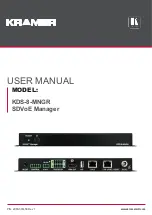
28
Thermal and acoustics
Thermal design
PowerEdge servers have an extensive collection of sensors that automatically track thermal activity, which helps regulate
temperature thereby reducing server noise and power consumption.
Thermal management of PowerEdge T640 delivers high performance for the right amount of cooling to components at the lowest
fan speeds across a wide range of ambient temperatures from 10°C to 35°C (50°F to 95°F) and to extended ambient temperature
ranges (see Environmental
Specifications).
The
benefits
to you are lower fan power consumption (lower server system power and
data center power consumption) and greater acoustical versatility.
Acoustical design
The acoustical design of the PowerEdge T640
reflects
the following:
•
Versatility: The T640 saves power draw in the data center but are also quiet enough for
office
environment in typical and
minimum
configurations.
You may
find
that the system is
sufficiently
quiet where the sound it emits blends into the environment.
•
Adherence to Dell's high sound quality standards: Sound quality is
different
from sound power level and sound pressure level in
that it describes how humans respond to annoyances in sound, like whistles and hums. One of the sound quality metrics in the
Dell
specification
is prominence ratio of a tone.
•
Noise ramp and descent at boot-up from power
off:
Fan speeds and noise levels ramp during the boot process (from power-
off
to power- on) in order to add a layer of protection for component cooling in the event that the system were not to boot properly.
In order to keep the boot-up process as quiet as possible, the fan speed reached during boot-up is limited to about half of full
speed.
•
Noise level dependencies: If acoustics is important to you, several
configuration
choices and settings are important to consider:
–
For lower acoustical output, use a small number of lower rotational- speed SATA hard drives, nearline SAS hard drives, or
non- rotational devices like SSDs. 15k hard drives generate more acoustic noise than that of lower rotational- speed hard
drives, and noise increases with number of hard drives.
–
Fan speeds and noise may increase from baseline factory
configurations
if certain
profiles
are changed by the user or the
system
configurations
are updated. The following is a list of items that impact fan speeds and acoustical output:
*
iDRAC9 BIOS settings: Performance Per Watt (DAPC or OS) may be quieter than Performance or Dense
Configuration
(iDRAC Settings > Thermal > Max. Exhaust Temperature or Fan speed
offset).
*
The quantity and type of PCIe cards installed: This
affects
overall system acoustics. Installation of more than two PCIe
cards results in an increase in overall system acoustics.
*
Using a GPU card: This results in an increase in overall system acoustics.
*
PCIe controller-based SSD drives: Drives such as Express
flash
drives and Fusion- IO cards require greater
airflow
for
cooling, and result in
significantly
higher noise levels.
*
Systems with an H330 PERC: This
configuration
may be quieter than those with an H730P PERC with battery backup.
However, higher noise levels result when a system is
configured
as non-RAID.
*
Hot spare feature of power supply unit: In the system default setting, the Hot Spare Feature is disabled; acoustical output
from the power supplies is lowest in this setting.
The T640 is a rack-capable tower server appropriate for typical
office
environment. However, for HPC usage with GPGPU, it is
recommended to install T640 in an unattended data center environment.
















































